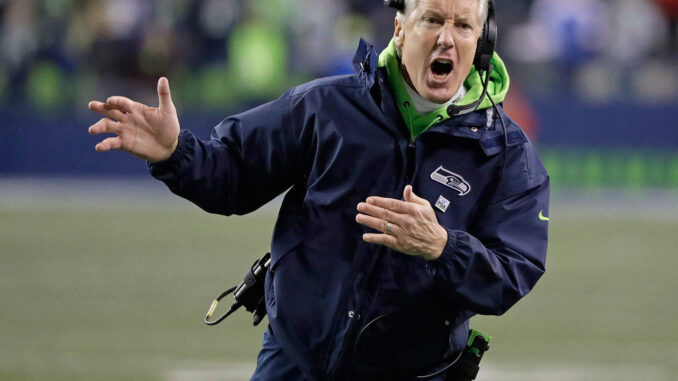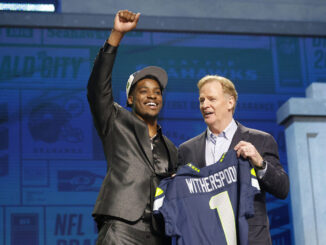
Well, that was a bummer. After bailing out in the first round to an inferior Los Angeles Rams team, one is forced to look at this season as a disappointment. It is a weird thing to say about a 12-win Seahawks squad that got to lift the division crown for the first time in five years, but here we are. The biggest cause was the lack of a clear identity, which was clear in Seattle’s loss to the Los Angeles Rams – especially on the offensive side of the ball. Before the season, I made some predictions about the Seahawks’ year would play out and we’ll review in this article how I fared along with some analysis about the season as a whole.
For the offense, I predicted that the narratives would be dominated by a Russell Wilson MVP campaign, a leaky offensive line, and the quest to find a third receiver. Early returns looked good for the Wilson hype train, as he got off to a ridiculous start, posting 26 touchdowns along with just 6 interceptions in the first eight weeks of the season and leading the Seahawks to a 7-1 record. The Seahawks had the number one offense in the league and the award looked like his as long as things held steady on the back nine. Well… let’s just say that didn’t happen. Seattle lost two games in a row against their best competition (LA and Buffalo) with Russ throwing four picks against two touchdowns. This seemed to lead to a clear change of pace in how this team would play, as Seattle decided to batten down the hatches on their flaming hot offense and structurally change play calling. Russell would not surpass 300 yards passing again for the rest of the season and would only throw two touchdowns to every interception in the second half of the year. Seattle would continue their winning ways, but Russell failed to put up the volume required to lift the hardware.
Russell’s struggles weren’t entirely his own though, as the offensive line which had looked like a surprising strength of this team early on, completely fell off a cliff near the end of the season. While Duane Brown remained a stud in both the running blocking and pass protection, the rest of the unit was inconsistent at best. Brandon Shell proved to be a shrewd offseason signing at the other tackle spot, providing above average pass protection when he was on the field according to Pro Football Focus. Unfortunately, he wasn’t always available, leading Seattle to rely on the abysmal play of Chad Wheeler, Jamarco Jones and Cedric Ogbuehi in replacement. Rookie guard Damien Lewis proved to be every bit the road grader they were hoping for but was a liability on passing downs as he allowed three sacks and was whistled for twelve penalties. On the other side of the line, Mike Iupati remained steady in his age-33 season, but continued to struggle with injuries as he missed seven games. His primary replacement, Jordan Simmons, failed to impress in his limited run as he allowed three sacks and struggled to open holes in the run game. At the pivot spot, starting center Ethan Pocic finished the season on a bad note after a strong start. While he only allowed two sacks and committed one penalty, Pro Football Focus graded him as a bottom-10 center in the league. As a whole, this unit gave up 48 total sacks, ranked ninth in ESPN’s pass block win rate with 62%, and were 16th in run block win rate at 70%. As a whole those numbers were a step up from previous years, but not good enough to prevent the best teams from getting to Russell Wilson when it mattered most. Seattle still needs upgrades at two positions on the offensive line (left guard and center) to truly protect their franchise star.
Lastly, I believed that the status of Seattle’s number three receiver would be the key to unlocking great offense. Philip Dorsett and Will Dissly were the two that I highlighted as clear candidates. Well… Dorsett failed to play a single snap due to multiple injuries that caused him to be placed on season ending injured reserve. Unlike Dorsett, Dissly actually played and contributed both as a solid pair of hands and as a blocker, but he failed to recapture the athleticism that made him into a threat downfield in both his rookie and sophomore seasons. Instead, it was David Moore as he finally took the leap in his fourth season that Seahawks fans were hoping for. His deep threat ability and speed were finally matched with consistency, as he hauled in 35 catches for 417 yards and 6 touchdowns. A particular favorite of Russell Wilson on deep bombs and short outlets, Moore proved himself to be a regular threat on the field. His biggest improvement was in catch %, has he improved nearly a full 25% from last season (74.5% chance to catch a pass thrown his way). While he is out of contract this season, Seattle will definitely look to bring him back as he is now a proven commodity.
The defensive side of the ball mirrored the offense, except it was more of a goofy, funhouse mirror rather than a normal one. The Seattle defense ranked dead last in the first eight weeks of the season, with the pass defense being the biggest culprit. But, due to both increased health and a couple important additions, Seattle flipped the script as they became an above average defense the rest of the way. Due to this topsy turviness, my predictions look pretty meh.
The first one in particular was a rough one on my part, as I had thought that the biggest “hot take” storyline would be that Seattle had found a second coming of the Legion of Boom. For a while there, it looked like that might go down as the singular, worst take in all of history. The grouping of Shaquill Griffin, Jamal Adams, Quandre Diggs and Quinton Dunbar looked fearsome on paper. Unfortunately, all four had to miss significant periods of time due to both health and disciplinary reasons. That, coupled with an embarrassingly bad pass rush, let opposing teams toss the ball all over the field. The Seattle pass defense as a unit yielded 2,897 passing yards at the midway point of the season, on pace to be the worst ever. BUT there was a change.
First was that Seattle traded for Carlos Dunlap and started blitzing like maniacs to no longer allowed quarterbacks to sit pretty in the pocket. Then Jamal Adams, Shaquill Griffin and Quandre Diggs all got (and stayed) healthy for the final half of the season. And lastly DJ Reed, a player picked off waivers before the season, came off injured reserve and played like a top 15 cornerback according to Pro Football Focus. All that allowed the secondary to stop leaking yards, as they didn’t give up a single 300+ passing yard performance in any single game over the final stretch of the season. While they were still a long way off the standards set by the Legion of Boom, they at least reached a level of competency that beforehand seemed unattainable.
The pass rush, as discussed before, also followed this trend. I advised readers then to follow Seattle’s blitz rate because their personnel on the defensive line was clearly going to struggle without additional help. It was true to an extent, as primarily Jamal Adams and Bobby Wagner were regularly sent as extra men on pass rushes to try to get pressure. Unfortunately, it didn’t have the cumulative results that they were hoping. Through eight weeks, Seattle only was able to muster 11 sacks collectively. It didn’t help that their best rusher, Bruce Irvin, went down with a season ending injury and that Jamal Adams was forced to miss a key stretch midseason. Seattle then decided to trade for Carlos Dunlap, as well as amped up their blitz rate even more. This change in both personnel and scheme worked amazingly well as they recorded 34 sacks in the remaining nine games of the season. Almost overnight, Seattle turned into a nightmare for opponents to try and block.
In conclusion, Seattle was basically Two-Face from the Batman comics. On one side was an offensive juggernaut, forced into explosive gun shows because they had the inability to slow down opponents. On the other was a defensive team that seemed to thrive the most when the offense was minimized to the nth degree. The failure of this season was the inability to merge those two identities into one and allow this team to meet its potential. It could be argued that Seattle had the ability to field a strong defense and a melt-your-face-off-offence this year but failed to do so because of both injuries and coaching. Russell Wilson went from an MVP lock to struggling to look better than a nine-fingered Jarod Goff in the wild card round. The Seattle pass defense went from historically inept to a genuine strength. The wild volatility of this team made them impossible to predict, so I’ll give myself an L across the board on my predictions. Going forward, Seattle needs to decide from the jump what type of team they are going to be. Getting caught flip-flopping your identity is what leads you to lose to a pitiful Rams team that easily got bounced in the divisional round.



